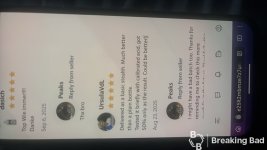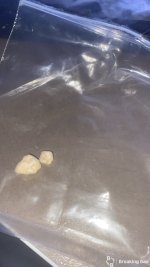- Joined
- Jul 5, 2021
- Messages
- 3,313
- Solutions
- 3
- Reaction score
- 3,812
- Points
- 113
- Deals
- 1
>>1. Titration
>>A small sample of base taken and and titration done. Result 50%. Not 52%, not 48%. It is precisely 50%, probably done by design, targeting this percentage.
Hello, Mr. president @Robert Fico . Can you describe how did you carried out titration procedure. I'm interesting in your method.
>>A small sample of base taken and and titration done. Result 50%. Not 52%, not 48%. It is precisely 50%, probably done by design, targeting this percentage.
Hello, Mr. president @Robert Fico . Can you describe how did you carried out titration procedure. I'm interesting in your method.
- Language
- 🇺🇸
- Joined
- Aug 10, 2025
- Messages
- 26
- Reaction score
- 6
- Points
- 3
OMG, general! You are an expert. Shall I teach you how to run titration? I learned this thing in my high school.
↑View previous replies…
- Language
- 🇺🇸
- Joined
- Aug 10, 2025
- Messages
- 26
- Reaction score
- 6
- Points
- 3
- By Robert Fico
You are right, General! There could be even less base than 50%, but my computer counted median value as 50.
Tell me what is this excess of HCl in mg per 100 ml of solution, even if ionic (salting) profile is counted? I would say that this value is negligible, especially if we take on account percentage gap for the dry NaOH. There is always at least 2% gap, but it matters for HPLC. It doesn't matter if I need to find out percentage of base with error gap 2%.
BTW, General, tell me how you remove these solvents, what is an easiest way apart from Chloroform?
Tell me what is this excess of HCl in mg per 100 ml of solution, even if ionic (salting) profile is counted? I would say that this value is negligible, especially if we take on account percentage gap for the dry NaOH. There is always at least 2% gap, but it matters for HPLC. It doesn't matter if I need to find out percentage of base with error gap 2%.
BTW, General, tell me how you remove these solvents, what is an easiest way apart from Chloroform?
Last edited:
- Joined
- Jul 5, 2021
- Messages
- 3,313
- Solutions
- 3
- Reaction score
- 3,812
- Points
- 113
- Deals
- 1
>>>Tell me what is this excess of HCl in mg per 100 ml of solution, even if ionic (salting) profile is counted?
What???
>>>BTW, General, tell me how you remove these solvents, what is an easiest way apart from Chloroform?
You can use non-polar solvent as DCM or hexane, which are dissolving amph base whereas not dissolving DMF and DMSO.
What???
>>>BTW, General, tell me how you remove these solvents, what is an easiest way apart from Chloroform?
You can use non-polar solvent as DCM or hexane, which are dissolving amph base whereas not dissolving DMF and DMSO.
- Language
- 🇺🇸
- Joined
- Aug 10, 2025
- Messages
- 26
- Reaction score
- 6
- Points
- 3
Wrong. DCM doesn't work at all. If you try to extract base from DMSO, these solvents will go together with base. It is a miracle for me, but it is true. Try to do you and check all the weights on each step, and you will see I'm right.
C6 works better, but it is very slow and it takes a special care to control the process. Manual process.
This fucking solvent is very hard to remove. I even found it in pretty noticeable QNT when was re-crystallizing meth. In the fucking meth ice I got this substance. It means, it is even built in crystal.
C6 works better, but it is very slow and it takes a special care to control the process. Manual process.
This fucking solvent is very hard to remove. I even found it in pretty noticeable QNT when was re-crystallizing meth. In the fucking meth ice I got this substance. It means, it is even built in crystal.
- Language
- 🇺🇸
- Joined
- Aug 10, 2025
- Messages
- 26
- Reaction score
- 6
- Points
- 3
I broke my brain trying to understand why I get around 10-15% less dry amph that it must be accordingly consumed acid if there is not more than 1-2% in the liquid leftovers. Sulphate shall not be azeotropic with ethanol. Not a bit.
I got an insight a couple of days ago: DMSO reacts with strong acids. That's why! If T is high, then this reaction runs very fast, but even if T is about 20-30C it is noticeable.
So when I do titration or add H2SO4 some part of acid reacts with this shit.
Apparently purity of this oil doesn't exceed 40%. @peaks you are a scammer.
I got an insight a couple of days ago: DMSO reacts with strong acids. That's why! If T is high, then this reaction runs very fast, but even if T is about 20-30C it is noticeable.
So when I do titration or add H2SO4 some part of acid reacts with this shit.
Apparently purity of this oil doesn't exceed 40%. @peaks you are a scammer.



